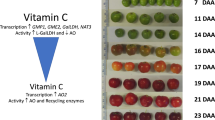Abstract
We evaluated differences in ascorbic acid (AsA) and glutathione (GSH) contents and activities of enzymes involved in the AsA metabolism in fruits of 20 cultivars of Chinese persimmon (Diospyros kaki). The total AsA content ranged from 3.85 (cv. Yangshuohuoshi) to 83.02 μmol·g−1 FW (cv. Wangmoshuishi), with an average of 36.69 μmol·g−1 FW across the 20 cultivars. The total GSH content ranged from 0.205 (cv. Yangshuohuoshi) to 0.815 μmol·g−1 FW (cv. Mimiguan) with an average 0.533 μmol·g−1 FW. There were significant differences in activities of dehydroascorbate reductase (DHAR, EC 1.8.5.1), monodehydroascorbate reductase (MDHAR, EC 1.6.5.4), ascorbate peroxidase (APX, EC 1.11.1.11), and glutathione reductase (GR, EC 1.6.4.2) in fruits among the 20 cultivars. The AsA content was significantly positively correlated with MDHAR and DHAR activities, but not with GSH and hydrogen peroxide (H2O2) contents or APX activity. These results indicated that both MDHAR and DHAR, especially MDHAR, play important roles in maintaining the AsA redox state by reducing oxidized AsA back to AsA and the AsA level mainly depends on biosynthesis, rather than recycling.
Similar content being viewed by others
Literature Cited
Badejo, A.A., Y. Fujikawa, and M. Esaka. 2009. Gene expression of ascorbic acid biosynthesis related enzymes of the Smirnoff — Wheeler pathway in acerola (Malpighia glabra). J. Plant Physiol. 166:652–660.
Chatterjee, I.B. 1973. Evolution and the biosynthesis of ascorbic acid. Science 182:1271–1272.
Chen, Z. and D.R. Gallie. 2005. Increasing tolerance to ozone by elevating foliar ascorbic acid confers greater protection against ozone than does increasing avoidance. Plant Physiol. 138:1673–1689.
Chen, Z., T.E. Young, J. Ling, and D.R. Gallie. 2003. Increasing vitamin C content of plants through enhanced ascorbate recycling. Proc. Natl. Acad. Sci. USA. 100:3525–3530.
Davey, M.W., A. Auwerkerken, and J. Keulemans. 2007. Relationship of apple vitamin C and antioxidant contents to harvest date and postharvest pathogen infection. J. Sci. Food Agr. 87:802–813.
Davey, M.W. and J. Keulemans. 2004. Determining the potential to breed for enhanced antioxidant status in Malus: Mean inter- and intravarietal fruit vitamin C and glutathione contents at harvest and their evolution during storage. J. Agric. Food Chem. 52:8031–8038.
Davey, M.W., M.M. Van, D. Inze, M. Sanmartin, A. Kanellis, N. Smirnoff, I. Benzie, J. Strain, D. Favell, and J. Fletcher. 2000. Plant L-ascorbic acid: Chemistry, function, metabolism, bioavailability and effects of processing. J. Sci. Food Agr. 80:825–860.
Debolt, S., V. Melino, and C.M. Ford. 2007. Ascorbate as a biosynthetic precursor in plants. Ann. Bot. 99:3–8.
Eltayeb, A.E., N. Kawano, G.H. Badawi, H. Kaminaka, T. Sanekata, I. Morishima, T. Shibahara, S. Inanaga, and K. Tanaka. 2006. Overexpression of monodehydroascorbate reductase in transgenic tobacco confers enhanced tolerance to ozone, salt and polyethylene glycol stresses. Planta 225:1255–1264.
Felicetti, E. and J.P. Mattheis. 2010. Quantification and histochemical localization of ascorbic acid in ‘Delicious’, ‘Golden Delicious’ and ‘Fuji’ apple fruit during on-tree development and cold storage. Postharvest Biol. Technol. 56:56–63.
Gautier, H., F. Lopez-Lauri, C. Massot, R. Murshed, H. Sallanon, and M. Genard. 2010. Impact of ripening and salinity on tomato fruit ascorbate and enzymatic activities related to ascorbate recycling. Funct. Plant Sci. Biotechnol. 4:66–75.
Goggin, F.L., C.A. Avila, and A. Lorence. 2010. Vitamin C content in plants is modified by insects and influences susceptibility to herbivory. BioEssays 32:777–790.
Grace, S.C. and B.A. Logan. 1996. Acclimation of foliar antioxidant systems to growth irradiance in three broad-leaved evergreen species. Plant Physiol. 112:1631–1640.
Griffith, O.W. 1980. Determination of glutathione and glutathione disulfide using glutathione reductase and 2-vinylpyridine. Anal. Biochem. 106:207–212.
Hancock, R.D. and R. Viola. 2005. Biosynthesis and catabolism of L-ascorbic acid in plants. Crit. Rev. Plant Sci. 24:167–188.
Homnava, A., J. Payne, P. Koehler, and R. Eitenmiller. 1990. Provitamin A (alpha-carotene, beta-carotene and beta-cryptoxanthin) and ascorbic acid content of Japanese and American persimmons. J. Food Quality 13:85–95.
Itoo, S. 1980. Persimmon, p. 442–468. In: S. Nagy and P.E. Shaw (eds.). Tropical and subtropical fruits, composition, properties and uses. Avi Publishing Inc, Westport, CT, USA.
Kampfenkel, K., M.M. Van, and D. Inze. 1995. Extraction and determination of ascorbate and dehydroascorbate from plant tissue. Anal. Biochem. 225:165–167.
Kusunoki, K., T. Hara, M. Fujita, Y. Minari, T. Tadokoro, S. Innami, and A. Maekawa. 1998. Histochemical observation and cellular distribution of ascorbic acid in persimmon leaves. J. Nutr. Sci. Vitaminol. 44:11–23.
Larkindale, J., J.D. Hall, M.R. Knight, and E. Vierling. 2005. Heat stress phenotypes of Arabidopsis mutants implicate multiple signaling pathways in the acquisition of thermotolerance. Plant Physiol. 138:882–897.
Lata, B. 2008. Apple peel antioxidant status in relation to genotype, storage type and time. Sci. Hort. 117:45–52.
Loreto, F. and V. Velikova. 2001. Isoprene produced by leaves protects the photosynthetic apparatus against ozone damage, quenches ozone products, and reduces lipid peroxidation of cellular membranes. Plant Physiol. 127:1781–1787.
Author information
Authors and Affiliations
Corresponding author
Rights and permissions
About this article
Cite this article
Pu, F., Ren, X. Ascorbate levels and activities of enzymes related to the glutathione-ascorbate cycle in fruits of Chinese persimmon cultivars. Hortic. Environ. Biotechnol. 55, 315–321 (2014). https://doi.org/10.1007/s13580-014-0177-4
Received:
Revised:
Accepted:
Published:
Issue Date:
DOI: https://doi.org/10.1007/s13580-014-0177-4




